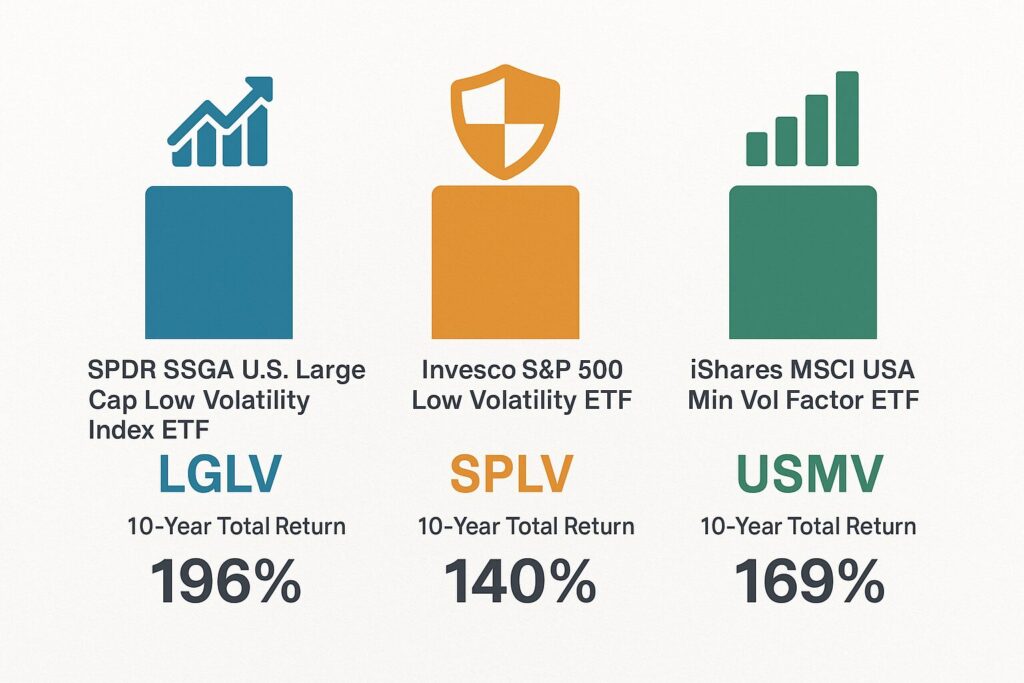
Steady returns. Smaller drawdowns. Less stress.
If you’re tired of the stock market’s roller coaster—and want a more peaceful path to long-term growth—low-volatility ETFs may be your best friend.
These funds are designed to track stocks with historically lower price swings, so you get more stability and fewer gut-wrenching drops. And over time, many of them match or even outperform the broader market—with a lot less drama.
In this post, we’ll explore some of the best low-volatility ETFs available today, why they deserve a spot in a conservative retirement portfolio, and how they’ve held up over the long haul.
✅ Why Low-Volatility Investing Works
Low-volatility ETFs don’t try to beat the market with risky bets. Instead, they focus on:
- Stocks with the most stable price history
- Sectors that hold up better in downturns (like utilities and consumer staples)
- Consistent dividend payers with strong fundamentals
The result? A smoother ride, fewer emotional decisions, and often similar (or better) returns than the market—especially during bear markets.
✅ Top Low-Volatility ETFs to Watch
Here are three standout low-volatility ETFs with long-term track records, solid portfolios, and smart design:
1. iShares MSCI USA Min Vol Factor ETF (USMV)
- 10-Year Average Return: ~10.1%
- Expense Ratio: 0.15%
- Why It’s Great:
USMV is one of the most popular and diversified low-volatility ETFs. It tracks a portfolio of U.S. stocks that exhibit lower price volatility while maintaining sector diversification. It avoids heavy overconcentration and has performed remarkably well through market turbulence.
2. Invesco S&P 500 Low Volatility ETF (SPLV)
- 10-Year Average Return: ~9.5%
- Expense Ratio: 0.25%
- Why It’s Great:
SPLV selects the 100 least volatile stocks in the S&P 500 based on trailing 12-month standard deviation. It tends to overweight defensive sectors like utilities and consumer staples. It’s simple, transparent, and tends to shine during market corrections.
3. SPDR SSGA U.S. Large Cap Low Volatility Index ETF (LGLV)
- 10-Year Average Return: ~10.8%
- Expense Ratio: 0.12%
- Why It’s Great:
LGLV uses a multi-factor strategy to select large-cap U.S. stocks with low volatility and strong fundamentals. It screens not just for low beta, but also earnings quality and stable balance sheets. A great pick for retirees looking for growth with downside protection.
🧓 Real-Life Example: Alice’s Sleep-Easy Portfolio
Alice, a 70-year-old retiree, had too much of her portfolio in high-growth tech stocks and found the volatility exhausting. She replaced a portion of her holdings with USMV, SPLV, and LGLV. The result? More stable monthly income, lower portfolio swings, and less anxiety when markets dip.
“I still get growth,” she says, “but without the heartburn.”
✅ What to Look for in a Low-Vol ETF
- Long-term return consistency
- Low standard deviation (fewer price swings)
- Exposure to defensive sectors
- Reasonable expense ratios
- Diversified holdings across stable industries
Low-volatility doesn’t mean no risk—but it does mean less drama and more discipline. And that’s a winning combo for retirement investors.
📘 This post is excerpted from my book:
Your Boring Portfolio: Get Off the Stock Market Roller Coaster and Sleep Well at Night With Low-Volatility Stocks,
Available now at Amazon.com in eBook and paperback formats.
Inside, you’ll learn how to build a low-volatility portfolio using ETFs, dividend payers, and defensive sectors that keep growing—even when markets stumble.
⚠️ Disclaimer
This post is for educational and informational purposes only. It is not intended as financial, investment, or tax advice. All investments involve risk, including the possible loss of principal. Please consult with a qualified financial advisor before making investment decisions. The author is not a licensed financial professional and does not offer personalized advice.